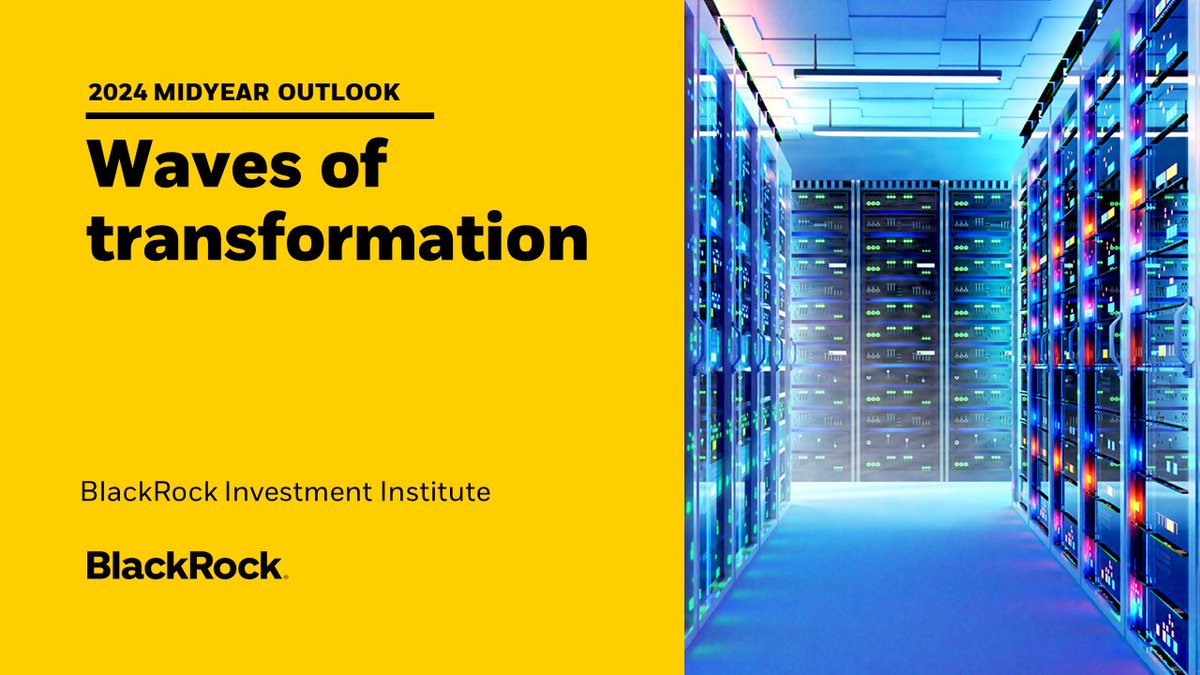
Waves of transformation
Waves of transformation
The world could be undergoing a transformation akin to past technological revolutions. But the speed, size and impact of that investment is highly uncertain. We think leaning into the transformation and adapting as the outlook changes will be key.

Stay ahead of the markets with insights from our strategists
Funds that match up with investing goals and values
Each investor has a different story, and we are steadfast partners to our clients in Canada because we listen to every one of them. Our full range of ETFs is one way we’re helping more investors build solid financial futures.
In one ETF, you can access thousands of global stocks and bonds. Choose the right portfolio mix based on your risk tolerance and investing style.
When you invest in equities (also called stocks) you buy a share in a company and become a shareholder. Equities are typically best for long-term investing – for those who are able to ride out the highs and lows of the market in search of higher rewards.
Rapid advances in exponential technologies, the low-carbon transition, infrastructure, and more are transforming the way we work and live.
Dividend ETFs pay monthly dividends, allowing you to earn a regular source of income and meet spending needs.
Fixed income securities, or bonds, are issued by companies and governments as a way of raising money. They’re basically an ‘I.O.U’ – designed to provide a regular stream of income (which is normally a fixed amount) over a specified period of time.
From funds that invest in precious metals such as gold and silver, to energy resources such as oil and natural gas, to agricultural goods such as wheat, commodity funds offer several potential benefits to investors, including portfolio diversification and a hedge against inflation.
Keep up with the latest from @BlackRockCA

We see waves of transformation on the horizon, driven by 5 mega forces – or structural shifts. We think that will create investment opportunities that transcend the economic backdrop. https://t.co/2mzHBY1ApM https://t.co/OCFz6cRSy1



journey: https://t.co/urOLrJiQTm https://t.co/fapjB6QOHQ

iShares Thematic ETFs can ease you into investing for the future 🚀 https://t.co/eVxnoxASl7 https://t.co/V2hVm7Quri
you kick-start your transition to retirement: https://t.co/G9ks3hjfog https://t.co/NW0R1RSu17


ABOUT US
BlackRock in Canada
Who we are
Meet our team
Helping you make sound financial decisions
Low-carbon transition investing 101
The transition to a low-carbon economy has emerged as a key player in the 5 mega forces that the BlackRock Investment Institute has outlined in recent episodes. But what exactly does it mean to “invest in the transition to a low-carbon economy,” and how are investors seizing this opportunity?
The Bid: “Low-Carbon Transition Investing 101”
Episode Description:
The transition to a low-carbon economy has emerged as a key player in the 5 mega forces that the BlackRock Investment Institute have been outlining for us in recent episodes. But what exactly does it mean to “invest in the transition to a low-carbon economy”, how are investors seizing this opportunity, and why is this transition seen as a “mega force” for investors?
Helen Lees-Jones Co-Head of the EMEA Sustainable & Transition Solutions group at BlackRock will reveal the questions investors are asking about the low carbon transition and explain the driving factors.
Sources: BlackRock iResearch Services global survey, sample size n=200, May-June 2023; BII Investment Perspectives Tracking the low-carbon transition (2023); Morningstar, Simfund, Broadridge. Data includes Sustainable Mutual Fund, ETF, Institutional and Alternative AUM, as defined by third party data sources, excluding integration/engagement flags. MF and ETF data as of Oct '21, Institutional & Alternatives data as of Jun '21.
Written Disclosures in Episode Description:
This content is for informational purposes only and is not an offer or a solicitation. Reliance upon information in this material is at the sole discretion of the listener.
For full disclosures go to Blackrock.com/corporate/compliance/bid-disclosures
TRANSCRIPT:
TRANSCRIPT:
<<THEME MUSIC>>
Oscar Pulido: Welcome to The Bid, where we break down what's happening in the markets and explore the forces changing the economy and finance. I'm your host, Oscar Pulido.
The transition to a low-carbon economy has emerged as a key player in the 5 megaforces that the BlackRock Investment Institute have been outlining for us in recent episodes. But what exactly does it mean to “invest in the transition to a low-carbon economy”, how are investors seizing this opportunity, and why is this transition seen as a “mega-force” for investors?
My guest today is Helen Lees-Jones, EMEA Head of the Sustainable & Transition Solutions group at BlackRock. Helen, will reveal the top questions investors are asking about transition investing and will highlight the particular areas in this field that are exciting investors. We'll also delve into the timing, the regional variations, and driving factors behind the transition. Helen, welcome to The Bid.
Helen Lees-Jones: Thanks so much for having me.
Oscar Pulido: So Helen, in recent episodes of The Bid, we've been discussing the five mega forces that Alex Brazier has introduced us to, and these are forces that are affecting investing both now and in the future, and creating opportunities and risks that investors can't ignore. The transition to a low carbon economy is one of those forces. So can you tell us why this is one of those mega forces?
Helen Lees-Jones: So, as you've heard, this is one of those mega forces, it's not the only one and as we think about advising investors and talking to them about what's happening in markets. We see that alongside the future of finance, the advent of digital technologies like AI, the transition to a low carbon economy is rewiring economies, sectors and businesses. And we see as a result of this transition the average investment in the energy sector increasing to $4 trillion per year over the next 30 years, that's up from only $2 trillion over the years past.
And so, as part of this rewiring of economies, that is creating both risks and opportunities for investors. And what we're seeing is that it's also channeling investment into both high carbon sectors and low carbon sectors. So, it's really a transition that is affecting the whole of finance and we are trying to put as much information into the hands of investors as possible.
When you think about this transition, there are really three key drivers behind it. You've got policy forces like the Inflation Reduction Act in the U.S. or the EU Green Deal, you've got the advent of new technologies like carbon capture, and you've got real changes in the way consumers and investors like to think about their investments. We also know that the transition to a low carbon economy, is playing out at different speeds in different regions, particularly when you look at developed markets versus emerging markets, as one example.
We see that the electrification of light vehicles is largely on track for 2050, whereas other sectors that perhaps have harder to abate emissions in the emerging markets need a significant amount of investment and or policy in order to drive that transition ahead.
Oscar Pulido: Okay, so just to reiterate, you're saying $4 trillion per year of investment in the energy sector over the next 30 years. That's a huge increase from what we're seeing now, and maybe we can take a moment to think about what does it mean to invest in the transition to a low carbon economy. In other words, what are some of the ways that investors are thinking about this opportunity?
Helen Lees-Jones: Great question! The definition of transition investing is something that continues to evolve, we're operating in a quite new space when you think about it. So, we at BlackRock have tried to put our own framework around it just to help investors think through the risks and opportunities associated with it. And we define transition investing in four ways, but the first area is around preparing for the transition. And that's where companies are investing in assets that make them better positioned for the transition, such as those improving and or leading on mitigating GHD emissions within their industry, either through their business operations, or their business models.
So, you're probably sitting there thinking, what on earth does that mean? Let's bring it to life a bit. As an investor, you're going to be thinking about companies that are outperforming their peer group, and we'd see in this category someone who is placing particular emphasis on reducing emissions intensity in their own operations and or deploying more CapEx than their competitors in that space into lower carbon solutions. So that's the first definition, those companies that are preparing for the transition.
The second is those that are aligned to investing in portfolios or assets on a decarbonization pathway that's aligned to an industry accepted low carbon scenario. So, you are an investor, you're looking at your portfolio, here, it might be an index or a portfolio that's aligned to a Paris aligned benchmark.
Thirdly, those companies that are really benefiting from the transition They're investing in assets such as those that are providing key inputs necessary for decarbonization that will benefit from the macroeconomic trends offered by the transition. Here you might think about the mining sector and a company that produces lithium. That's a key input into electric vehicles and the batteries within electric vehicles. So, a company that is leaning into lithium production, we would see as benefiting from the transition to a low carbon economy.
And then finally, those companies that are contributing to the transition. So here this might be companies who are investing in solutions or interim low carbon alternatives that are needed to mitigate emissions in the real world. So here examples might be wind farms, or grid scale batteries. So those are really the four ways in which we are defining transition investing here at BlackRock.
But when we think about investors and what's driving their preferences in transition investing, you see a range of interest from investors worldwide. Some want to look at it through a whole portfolio lens, you tend to find the big institutions who have made whole portfolio commitments seeing this as really something they want to see throughout their whole portfolio. Others who are very much focused on the thematic opportunities associated with the investment, like investing in specific sectors, minerals, materials, would want to play it thematically. But the prevailing interest that we are seeing is in the private market space because we see that the transition is driven by new technologies and new businesses that don't exist today. The real innovation that's going into this space requires an awful lot of private capital.
Oscar Pulido: That framing was very helpful that description of the various ways in which somebody can go about investing in the transition to a low carbon economy. I wonder if you could maybe give us a few real-life examples that might help someone who's learning about this investment space for the first time. You mentioned batteries. What are some of the opportunities that exist in the battery and carbon capture space?
Helen Lees-Jones: Of course, two exciting areas in which to invest. When we think about carbon capture, we have a brand-new joint venture with a US oil major on this very topic because as you will know from what I've talked about so far, traditional oil and gas producers are really key to meeting the world's growing energy. Even with the rapid build out of clean energy infrastructure, we still see that there's a space for emissions removals capabilities to come online. So, carbon capture is really there to use new technology to remove large amounts of carbon dioxide from the atmosphere and put it back into the ground.
On the battery side of things, they're essential to the transition to a low carbon economy, whether it's from powering electric vehicles or ensuring grid reliability. And we have also in our infrastructure business invested in a super battery in Australia, it's there to ensure that it stabilizes energy grids as they shift to renewable sources. When you think about it the wind only blows for a certain amount during the day, the sun only shines for a certain amount during the day, so being able to harvest that renewable energy supply, store it and then transmit it when it's needed, those grid scale batteries are critical to ensuring that we can make the most from those renewable energy sources. So those are just two examples, carbon capture, grid scale batteries.
Perhaps the third space, whilst we're talking about batteries is next generation materials that are needed. Batteries are now prevalent everywhere, whether it's in your electric car, or in other parts of your Day-to-Day life and those batteries need to become higher performing more efficient, more sustainable. So, looking at new materials and minerals that are required in order to make those batteries better, is also another interesting area for investment opportunities.
Oscar Pulido: And so, Helen going back to the numbers you referenced earlier about the investment in this space doubling, what impact will that have on opportunities for investments going forward?
Helen Lees-Jones: So obviously with that significant scale of CapEx going into new energy sources, there's an array of opportunities across the world. This transition isn't happening just in one sector or one country, this is something happening globally. I talked about, a super battery in Australia or a carbon capture facility in the U.S., there are other areas in which we are investing in transition assets. Pipelines as one example, we're looking at ways in which we can invest in building thousands of miles of critical infrastructure to help transition from oil to natural gas and clean hydrogen. So, it is about taking some of that infrastructure that exists and finding ways in which it can both continue to deliver the oil and gas that is being produced today but also be converted in the future into a way of transmitting newer energy sources like clean hydrogen.
Electric vehicles, we've made a pretty significant investment into a continental European EV charging company, which installs and manages high speed electric charging stations. Their goal is really to be the biggest charging facility provider across Europe, and they're already operating one and a half thousand chargers across the continent today. As we see wider adoption of electric vehicles coming online, those drivers are going to want the convenience of being able to charge wherever they wish. you can charge your vehicle at a petrol station wherever you like today, but the infrastructure still needs to be built out in order to charge your electric vehicle. And the goal there is to ensure that around every 150 to 200 kilometers on European highways, you can access the convenience of EV charging as you drive.
Perhaps if we look at the more renewable end of the investment opportunity set, you can think about solar power. We can see big opportunities in solar power, we have significant investments across our portfolio today, we've invested, in a renewable energy developer in the Philippines as another example of where we see global opportunity. So yes, this is happening in, developed markets, but increasingly we're seeing much more opportunity coming across in the developing markets.
And those transition assets are not only helping transition from browner sources today to greener sources tomorrow, but they're also providing resilience and security, which importantly we see as key characteristics of the transition. Yes, of course we want it to be green and lower emissions, but also it needs to be consistent, and it needs to be stable. Things like solar power and battery storage are a key component of that transition, so for investors, there's a wide array of infrastructure, assets and technologies in which to invest globally.
Oscar Pulido: So Helen, you may have recently listened to an episode we did with Portfolio Manager Charlie Wilford around electric vehicles, and he commented on some of the charging infrastructure challenges that you mentioned as well. You also mentioned policy as a driver of the transition, and you touched on the Inflation reduction Act in the us. And the EU’s Green Deal package. What impact does policy have on investment opportunities and what challenges might it present?
Helen Lees-Jones: Great question because the policy landscape is a really critical input into how you think about making investments, particularly as long-term investors. What we've seen with new policy come online, whether it's the US Inflation Reduction Act, whether it's the EU's Green Deal package, there's been a significant investment of policy and subsidy into both the US and European marketplaces, we're seeing other parts of the world also come online, Japan most recently. The policy support is huge in this space, that catalyzes investment, which is what we want to see, but it also does create risks when you think about how that policy is going to be deployed.
Things that you might want to consider are things like policy changing. So, policies are enacted normally aligned to political cycles, what happens if a different, political party comes in or the government is managed differently, will those policies endure or will they look different or be removed entirely. And so that's a risk to consider when you think about just the feasibility and long-term nature of policy.
The second thing is that huge wave of investment that it generates can also create bottlenecks, whether that's in your supply chains, getting hold of critical raw materials and minerals, that wave of demand can also generate bottlenecks in your supply chains. And then you've got the issue of permitting risk. The policy support is there, the money is there to put to work, but are you allowed to actually go ahead and build that new project? And often you require permits in order to put those infrastructure projects in place.
And that in itself comes with risk, not all projects actually end up getting the permits they expected to get, and we've seen some of that play out recently. So, policy is a great mechanism. It comes with huge opportunity, but it does come with some risks as well. And importantly investors in this space want to work with a partner who can understand and help navigate all that complexity that I just talked about.
Oscar Pulido: And do we have any data how many institutional investors are already thinking about this for the future or are they already investing in the transition?
Helen Lees-Jones: So that's a timely question, Oscar, because we recently surveyed 200 institutional investors globally over the summer, and a whopping 56% of them indicated that they plan to allocate more to the low carbon transition over the next few years. Some are looking at it through a whole portfolio lens, they want to really think through how do they hit net zero targets if they've made them, others think about it from an asset class perspective, so where can they generate the highest and best, investment return in their portfolio and or manage the risk that it generates.
Oscar Pulido: So 56%, that's a significant portion of the investors you surveyed, and I'm curious, as this is a relatively new space, how has that number changed in recent years? Is that a big shift in investor preferences into investing in the low carbon transition?
Helen Lees-Jones: We have seen a change in investor preferences particularly since three years ago. We've seen the world change around us, we've seen a shift in the geopolitical context, we've seen, unfortunate crises with energy supply, with geopolitics. That has changed to some extent the way investors think about their objectives as fiduciaries to their assets. thinking out over both a, 1, 3, 5, 10, 30-year horizon, you've got to adjust to, what's going on around you. And of course, the transition. Isn't necessarily linear. So perhaps three years ago, investors who were interested in the space would've been very much focused on things that you'd perceive to be green today.
They'd be very invested in your renewable energy sources like solar and wind, and having quite restrictive exclusions in their portfolios, they might have chosen particular sectors that they felt were not aligned to sustainable investing and excluded them from the portfolio. And as I said, today, we've seen the conversation shift quite considerably, and investors are much more interested in assets that are greening, so they're transitioning, and hence why we're so focused on the transition in all its frames.
Because when you think about what this means in a portfolio, an exclusionary approach doesn't get you to where you want to be necessarily. You understand that the biggest drivers of this transition are also perhaps the industries, sectors, companies who aren't necessarily the greenest today, they've got big plans to transition and they're putting a significant amount of time, energy, and resources into thinking through how do they get to where they'd like to be over a long horizon.
But those things can't be done overnight, and we're seeing a much bigger preference towards transition assets. And I think importantly, the dialogue is really shifting as well between investors and corporates, and we're seeing much more of a partnership approach between incumbents and disruptors.
Rather than just seeing the new technologies recast the playing field, we're seeing much more interaction between traditional sectors today in traditional companies within those sectors, partnering with the challenger technology providers, challenger companies in the same sector. And we see that coming to life in investors’ portfolios. So, whilst they'll invest in perhaps the traditional sectors today, they'll also be investing in newer technologies through their private markets allocations to almost go alongside what they have in their public markets portfolios. This is something that we see as an important part of the transition investing opportunity set that it really is a whole ecosystem opportunity and that, investing across a wide range of assets, sectors, capabilities is just a great opportunity for investors.
Oscar Pulido: So basically what you're saying is that the good news for investors is that there are a whole multitude of ways to think about investing in this transition to a low carbon economy. Helen, thank you so much for this 101 on transition investing. It really does sound like there are a lot of exciting opportunities in the space right now. And thank you so much for joining us on The Bid.
Helen Lees-Jones: Thanks so much for having me.
Oscar Pulido: Thanks for listening to this episode of The Bid. If you enjoyed this episode, check out our recent episode “The Race is On For EVs” where portfolio manager, Charlie Lilford, unpacks the contribution of transport and electric vehicles in the transition to a low carbon economy.
Subscribe to The Bid wherever you get your podcasts.
<<THEME MUSIC>>
<<SPOKEN DISCLOSURES>>
This content is for informational purposes only and is not an offer or a solicitation. Reliance upon information in this material is at the sole discretion of the listener.
For full disclosures go to Blackrock.com/corporate/compliance/bid-disclosures
MKTGSH1123U/M-3243169


